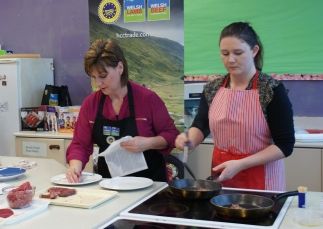- Home
- News & Industry
- Teachers to help kids get to grips with food provenance
Teachers to help kids get to grips with food provenance

Teaching youngsters about where their food comes from and helping schools to deliver a comprehensive new food qualification were top of the agenda in Menai Bridge this week, as teachers from across north Wales gathered at a training event.
The course was organised by Hybu Cig Cymru – Meat Promotion Wales (HCC) and education consortium GwE, and focused on how to deliver a new GCSE food qualification in secondary schools. The course offered teachers the chance to take part in practical hands-on sessions which they could use to educate youngsters about the science behind the preparation of meat and other foods.
The training also covered food provenance, which has been a cause of much debate in recent years. Research has found that many children are confused about where their food comes from. A British Nutrition Foundation survey found that 10% of secondary school age children believed that tomatoes grew below ground, 5% thought bread came from cows, and 18% had never visited a farm.
The new GCSE in Food and Nutrition, launched this year by the Welsh Joint Education Committee, offers a chance to get to grips with these issues, according to HCC’s Consumer Executive Elwen Roberts.
“I was delighted to see teachers from across north Wales at the event in Ysgol David Hughes,” said Elwen.
“The new GCSE in Food and Nutrition, which replaces some of the old qualifications, is a very positive step in dealing with the science of food, food preparation and balanced diets,” she added. “It also gets to grips with food traceability and provenance. Schemes such as PGI (Protected Geographical Indication), of which Welsh Lamb and Welsh Beef are part, give confidence to consumers about the origin and quality of their food.”
HCC, along with Meat and Education, have developed a range of learning resources to help teachers to deliver the new GCSE, including ideas for students’ written investigation projects which count for a fifth of the final mark.
“Our resources illustrate how red meat is a high biological value protein, containing many essential nutrients required as part of a balanced diet. We also have resources explaining the composition of red meat and how different processes and cooking methods affect the texture of meat,” explained Elwen.
The bilingual resources will be made available via the ‘Hwb’ learning portal, and on the HCCTrade.com website.

